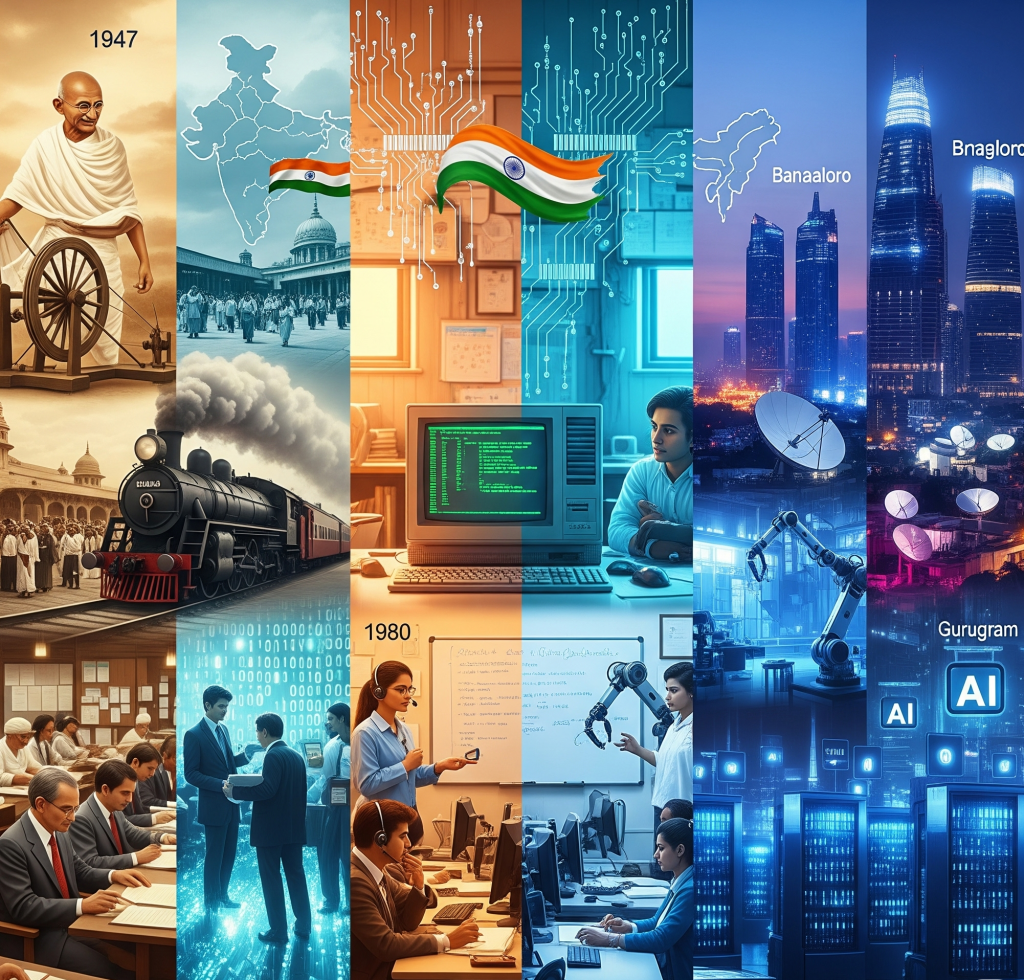Introduction
In 1947, India stood at the dawn of independence with a fragile economy and a limited technological base, far from the Global Tech Hub it would one day become. The nation had inherited outdated communication systems, minimal industrial capacity, and almost no presence in the computing or electronics sector. Yet, in just over seven decades, India has evolved into a global technology powerhouse leading in software exports, IT services, and innovation in AI, robotics, and emerging tech. This transformation is a result of visionary government policies, investments in education, strategic global partnerships, and the entrepreneurial spirit of millions of Indians.
How Did Government Policies Shape the IT Sector?
Government policies have played a crucial role in establishing the foundation for India’s IT achievements. In the initial years, figures such as Jawaharlal Nehru prioritized scientific research and technical education, leading to the establishment of institutions like the Indian Institutes of Technology (IITs), which laid the groundwork for India’s emergence as a Tech Hub.
Key policy contributions include:
- Creation of IITs, IIMs, and NITs to provide top-tier technical talent.
- Formation of the Department of Electronics in 1970 to oversee technology initiatives.
- The Software Technology Parks of India (STPI) in the 1990s, which provided infrastructure and tax benefits for exporters
- The IT Act of 2000, which granted legal recognition to electronic commerce.
- The Digital India Initiative launched in 2015 aimed at enhancing broadband connectivity, e-governance, and digital literacy.
These initiatives fostered a supportive environment in which IT companies could flourish both domestically and internationally.

What Changed in Technology After 1947?
- 1950s–1960s: Technology centered on heavy industries, with mainframe computers introduced in government labs.
- 1970s–1980s: Introduction of minicomputers, growth of state-owned IT firms like ECIL, and the start of computer education.
- 1990s: Economic liberalization, internet arrival, and birth of India’s outsourcing industry.
- 2000s: Rapid broadband expansion, mobile revolution, and e-commerce startups emerging.
- 2010s–Present: Surge in AI, fintech, cloud computing, edtech, and renewable energy tech innovations.
Every decade marked a leap, laying the groundwork for the digital economy we see today.
How Is India Competing in AI, Robotics, and Innovation Today?
India is now at the forefront of technical innovation. With more than 3,000 AI startups and substantial research and development investments from both the government and private sectors, the nation is implementing artificial intelligence across various fields such as healthcare, agriculture, logistics, and finance.
Robotics is increasingly being adopted in manufacturing facilities, warehouses, and defense applications. Initiatives like the National AI Mission are designed to incorporate advanced machine learning into governance and business practices.
Furthermore, Indian companies are collaborating on research projects with global leaders in quantum computing, blockchain, and green technologies, ensuring the country’s position as a key Tech Hub in the Fourth Industrial Revolution.
How Was India’s Tech Scene in 1947?
In 1947, India’s technology industry was nearly non-existent according to contemporary standards. Communication depended on telegraphs, radio communications, and restricted telephone connections. Industrial equipment was brought in, and computers were not common in daily life. The majority of scientific advancements originated from public sector research organizations such as the Council of Scientific and Industrial Research (CSIR) and the Indian Statistical Institute, which were in their early stages of development. The nation experienced a lack of skilled engineers and scientists, leading to a strong reliance on foreign expertise for significant projects. Even with these constraints, the dedication to building an independent scientific foundation was clear, paving the way for a future Tech Hub.
Which Global Deals Boosted Growth?
- Partnership with IBM in the 1950s and later in the 1990s for computer education and hardware supply.
- Y2K Opportunity (1990s): Indian IT firms were heavily relied upon to fix the millennium bug, opening doors to global trust.
- Offshore Outsourcing Contracts with US, UK, and European corporations during the early 2000s.
- Cloud Infrastructure Investments from tech giants like Amazon Web Services, Microsoft, and Google.
- Collaborations in Space and Defense with NASA, ISRO, and European Space Agency, strengthening India’s research capabilities.
These partnerships not only brought revenue but also transferred skills and technological know-how.
How Did Outsourcing Put India on the Global Map?
The rise of outsourcing marked a pivotal moment for India’s IT identity. In the mid-1990s, global companies recognized they could transfer customer support, software development, and data processing to India at a significantly lower cost while maintaining quality.
The main influencers were:
- Expert English-speaking labor force educated in STEM disciplines.
- Beneficial time zone variation enables round-the-clock business activities for international clients.
- Affordable prices while maintaining service excellence.
- Demonstrated proficiency in managing large-scale projects.
Firms such as Infosys, Tata Consultancy Services (TCS), and Wipro evolved into international powerhouses, rendering “Made in India” synonymous with dependable, scalable technology services.
Conclusion
From a country with little technological infrastructure in 1947 to a prominent leader in global IT and innovation today, India’s path is characterized by vision, determination, and strategic initiatives. Robust government strategies, a skilled workforce, and advantageous global collaborations have formed the foundation of this transformation.
With AI, robotics, and advanced technology creating new opportunities, India is no longer playing catch-up it’s actively influencing the global tech environment. Platforms like Wiraa further amplify this progress by connecting skilled professionals with global opportunities, ensuring that India’s talent pool continues to contribute to cutting-edge projects worldwide. This significant transformation serves as evidence that the appropriate combination of education, policy, and innovation can alter a nation’s fate.



